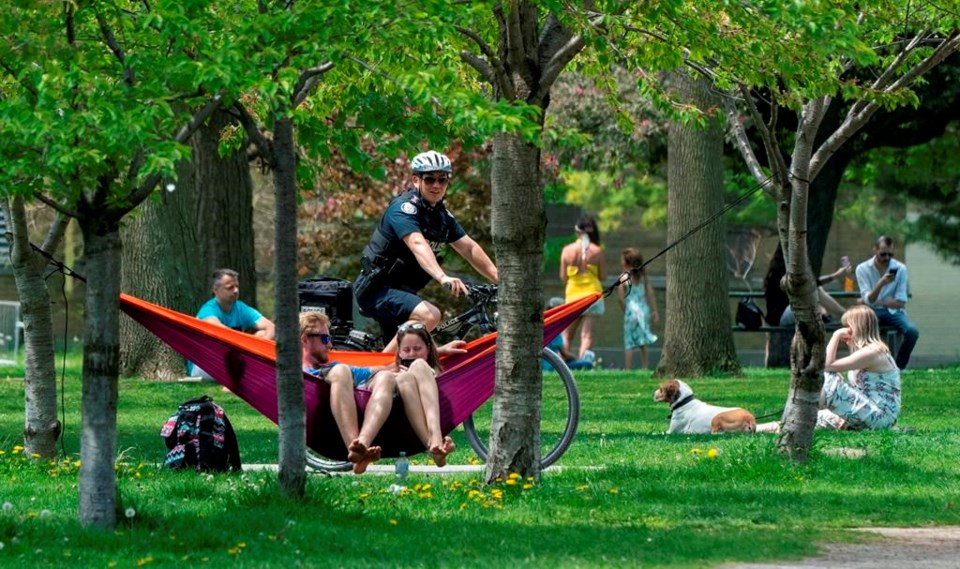
Packed parks like Bellwoods avoidable with better communication, experts say
Images of a downtown Toronto park packed with young people seemingly flouting physical distancing guidelines designed to slow the spread of COVID-19 have drawn sharp criticism from both politicians and the public.
by Canadian PressImages of a downtown Toronto park packed with young people seemingly flouting physical distancing guidelines designed to slow the spread of COVID-19 have drawn sharp criticism from both politicians and the public.
But a trio of experts suggested Monday that the bigger issue is that safety guidelines are being communicated to the public inefficiently, and there's a lack of options for safe social connection in Canada's urban centres.
"Unfortunately, probably the worst thing that we've done — amongst the many bad things we've done with COVID — is we haven't facilitated people doing low-risk behaviours," said Dr. Andrew Morris, professor of medicine at the University of Toronto and medical director for Mount Sinai Hospital's Antimicrobial Stewardship Program.
"We've treated low-risk behaviours and high-risk behaviours as the same thing."
Morris also pointed out that most of the people at Trinity Bellwoods on Saturday were young people who can't afford homes with backyards or even balconies. With air-conditioned public spaces such as libraries and coffee shops closed, the options for many people are limited as temperatures soar.
And Toronto's youth aren't alone in their misstep, as similar scenes played out on Vancouver's beaches in the first weeks of the pandemic and at Ottawa's tulip festival on Mother's Day.
The apparent disengagement of young Canadians was underscored by a study done by Carleton University and Abacus Data that looked at how different demographic groups have responded to the COVID-19 pandemic.
The national survey of 2,000 Canadians conducted in early May found that young adults were more likely to suffer negative effects to their income because of the public health emergency. It also suggested they would be more bullish about the need to reopen the economy, less inclined to keep up with the news about the pandemic and less likely to follow physical distancing guidelines.
Josh Greenberg, a professor of journalism and communications at Carleton who was part of the survey team, said that given that report, he was not surprised that young adults would congregate in a park. He suggested more nuanced messaging by public officials would be helpful.
"We know that our common messaging is working for some segments of the population but not others," said Greenberg. "Certainly a more segmented, democratic, demographically specific approach is important."
Ontario Premier Doug Ford was one of the people disappointed in the large turnout at Trinity Bellwoods, expressing his frustration during a news conference Monday afternoon.
"Just don't do reckless things like that," Ford pleaded. "There are obviously smart young people in this city.... I'm thinking, 'Wow, that's the last group I'm thinking that would be out there.'"
Ford also said that anyone who was at the park on Saturday should go get tested for COVID-19.
Less than two hours later, Dr. Barbara Yaffe, the province's associate chief medical officer of health, said the park-goers should not get tested but instead self-monitor for symptoms of the virus for 14 days and avoid contact with high-risk individuals.
That kind of mixed messaging has led to confusion and essentially given people an opportunity to do what is most appealing to them, said Morris.
"You haven't really given (people) a better option for what to do," said Morris. "You told me what I can't do. But you really haven't made it easy for me to do what you really want me to do."
Tim Sly, a professor emeritus at Ryerson University's school of occupational and public health, said that after three months of messaging about physical distancing, people are starting to tune out the warnings.
"I think we need to bring in reminders that are sufficiently different or newly flavoured or newly owned to create a new sense of urgency," said Sly, pointing out that public health officials are easy to ignore when life outside seems normal. "It looks good out there — there's nothing you can see that's different.
"Let's face it: (If) somebody really is ill, you won't see them in the park."
This report by The Canadian Press was first published May 25, 2020.
John Chidley-Hill, The Canadian Press